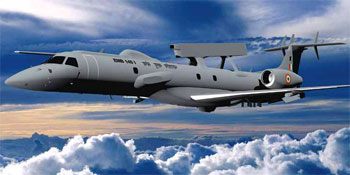- Prime Minister Narendra Modi inaugurates Aero India 2023 in Bengaluru; Releases Commemorative Stamp
- Defence Secretary meets delegations from Saudi Arabia, USA and Oman on the sidelines of Aero India 2023
- Foreign Ministers of 32 countries to attend Aero India 2023
- Embraer showcases the C-390 Millennium at Aero India 2023
‘We see an opportunity to supply cost-effective equipment’
Orlando Jose Ferreira Neto, Commercial Vice President Embraer Defense and Security

SP’s Show News (SP’s): Can you briefly outline the main features of and division of responsibility in the project undertaken jointly between Embraer and Indian DRDO for AEW&CS platforms?
Orlando Jose Ferreira Neto (Orlando): Basically DRDO is responsible for the mission systems and Embraer is responsible for the platform. The platform also includes the aircraft modifications in order to fulfil the mission systems’ requirements and physical integration. The main improvements in the platform are the inclusion of air-to-air refuelling equipment (AAR), additional electrical power generation and a cooling system designed to cope with the demands of the Indian mission system under development by DRDO. Regarding the physical integration of the mission systems, one can notice not only the obvious AEW radar antenna, but also systems such as IFF, Satcom and others.
SP’s: There are how many similar systems on the ERJ 145 platforms, in which countries, and for how long have they been in operational deployment? What has been the experience so far?
Orlando: ERJ 145 platform forms the base of Embraer intelligence, surveillance and reconnaissance (ISR) family comprising AEW&C, maritime patrol and airborne ground surveillance (AGS) variants. There are currently 15 EMB 145 ISR aircraft operating in three different continents. Ten of them are of the AEW&C variant, similar to the one being developed by DRDO in India. The Brazilian Air Force operates five of these AEW&C aircraft. The Hellenic Air Force operates four of them, and the Mexican Air Force operates a single aircraft. Brazil is the sole operator of the AGS variant and has three aircraft in its fleet. As for the MP variant, two aircraft are operated by Mexico, which also operates a C4I system acquired from Embraer.
Brazil operates its ISR fleet, both AEW&C and AGS, since 2002. They are part of the Amazon Surveillance System (SIVAM) programme. Acting together with the Super Tucano light attack aircraft, the EMB 145 ISR aircraft form an umbrella that is deterring drug smuggling, border infiltration, guerrilla and other illegal activities in the region.
In Mexico, the aircraft started operations in 2004 and Greece started operations with its EMB 145 AEW&C fleet in 2009.
SP’s: In what way will the ERJ 145 based AEW&CS be different from or complement the IL76 based AWACS that the IAF has already acquired?
Orlando: The EMB 145 AEW&C from DRDO makes use of indigenous mission systems developed by DRDO/CABS. The Il-76 AWACS operated by the Indian Air Force is equipped with imported mission systems. We don’t have information enough to compare those two systems, nor know how the Indian Government is planning to make use of both assets.
SP’s: What are the advantages or disadvantages of a fixed antenna as planned to be installed on the ERJ145 vis-a-vis a rotating antenna?
Orlando: The fixed antenna is a much more reliable and lighter solution. The radar beam is steered electronically with no need of moving parts, making it sleeker and therefore more adequate to install in a smaller and more economical platform as the ERJ 145. Due to the high technology embedded, the radar performs as well as the old and bulky rotating ones. Nowadays, with the maturing AESA technology, rotating antennas are losing space.
SP’s: How is the modification of the three Embraer 145 jets progressing in Brazil? When is the first aircraft expected to undertake its maiden flight?
Orlando: The work is progressing as planned. There are currently two aircraft already assembled and under modifications to receive the missions systems. The third one is currently being assembled. Embraer is proud to inform that the aircraft will be presented soon and will make its maiden flight in the first semester of this year.
SP’s: Embraer caused a fuss in the defence market when it announced the development of a new military airlift, the Embraer KC-390. Is it progressing well? What is the current status of the KC-390?
Orlando: The KC-390 programme is progressing on schedule. Currently, Embraer is selecting the main suppliers for the aircraft, which is set to have its maiden flight in 2014.
SP’s: Embraer is also in the counter-insurgency aircraft market. Does Embraer see a growth in this segment?
Orlando: Yes. The defence scenario today is such that more and more we witness the armed forces being employed in mission against terror, piracy, insurgents and criminal activities like smuggling and even environmental crimes. On the other hand, most armed forces inherited means designed during the Cold War to be effective in that scenario and that are not effective to deal with current demands. We see an opportunity to replace the legacy equipment, supplying countries with cost-effective equipment that are designed to meet the demands of the 21st century.
SP’s: What changes can we expect with the new Embraer Defense and Security unit?
Orlando: Embraer Defense and Security will have a broader spectrum of activities, beyond aircraft and airborne systems. We see a company that will greatly increase its capabilities and in doing so is open to partnerships in many different businesses.





